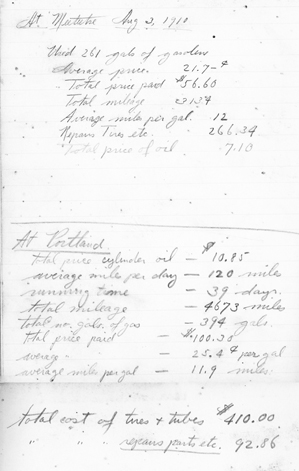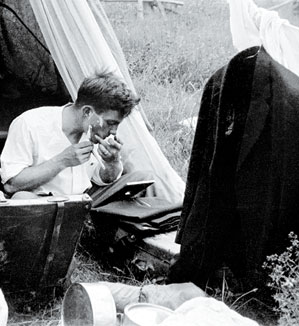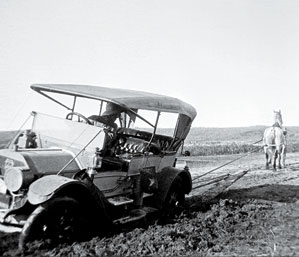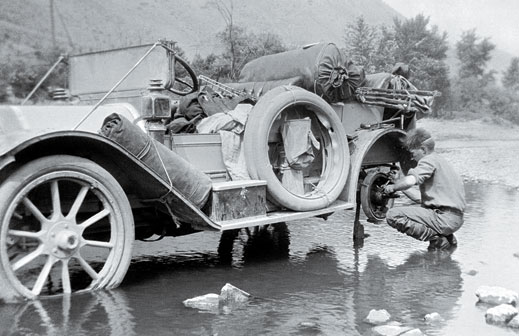A Turn-of-the-Century Road Trip
On June 25, 1910, two MIT students set off on an adventure. Joseph Cheever Fuller, Class of 1911, and Alfred Hague, Class of 1910, left Fuller’s home in West Newton, Massachusetts, in Hague’s 1909 Oldsmobile and headed for Portland, Oregon. Theirs was not the first cross-country auto trek, but most started or ended in San Francisco to take advantage of the best roads. Fuller and Hague were attempting a much more arduous and less-traveled northern route because they wanted to stop to visit Hague’s brother at his ranch in Meeteetse, Wyoming. Through sheer force of will—and frequent application of their engineering know-how—the students coaxed their vehicle across the country, over terrain better suited to horses than automobiles.

“It was west of the Mississippi that we began to be pioneers and as we wound our way to the northwest we saw thousands of people who had never seen an auto before,” Hague recollected in 1950. “Our arrival in a town brought out a crowd and many invitations for meals from those who had some contact with the east no matter how remote. At night we always drove out on the prairie or on to some ranch where we pitched our tent for the night. We went from town to town by sighting, on the grain elevator or by compass … Road maps of the west were non-existent … We had to use railroad timetable maps which were somewhat distorted to make the road look direct.
“The modern filling station was not even a dream and repair shops far and few between. We had to do all of our own repair work including forging. Getting gasoline was often a problem, but inquiry would usually locate some store that had a few five gallon tins.”
In 39 days on the road, Fuller and Hague encountered rattlesnakes, prairie fires, a hail storm, and roads so rough that they found themselves making almost daily—and often major—repairs. On August 31, they boarded a ferry in The Dalles, Oregon, that took them on a 12-hour journey along the Columbia River to Portland, where accounts of their trip appeared in the papers. Because they had to be back at Tech on September 28 for the fall semester, they shipped the car east and made the long trip home by train.
In typical MIT fashion, Fuller kept meticulous records of the journey and their ministrations to the “machine” that transported them. His careful tally of expenses shows they spent four times as much on tires and tubes ($410) as they did on gas ($100.30). Fuller’s son, David, has preserved his father’s journal and photos from the trip, as well as transcriptions of the 40 postcards and letters he sent home; all are collected in the 2012 book Transcontinent 1910: The Automotive Adventures of Two Young Men, edited by Mark H. Chaplin. The condensed excerpts that follow give a sense of the pluck, ingenuity, and engineering skills that made Fuller and Hague’s ambitious trek possible.

Albany, New York, June 25
Blowout at 6.40 a.m. Under way at 7.10. Arrived at Springfield at 11.15. Fixed brake at Spencer, one hour. Broke front spring. Ran over a cat, didn’t hurt her. Lost Prestolite tank bracket. Arrived at Albany at 5.30 p.m. Going to camp between here and Schenectady.
Syracuse, New York, June 26
Feeling like a King. No accidents to speak of to-day.
Lake Erie, June 28
Arrived Buffalo about 7.30. Got shave and haircut and then went to the Falls. Camped at Van Buren, on the shore of the lake. Washed clothes and had a swim. Puncture left front.
Ligonier, Indiana, July 2
Rotten roads in this state. Yesterday pin came out of radius rod, let the back wheels back, and the shaft and both universal joints fell out on the road. We found all the parts and got it together in two hours. To-day we broke a front spring and put in another on the road.
Chicago, Illinois, July 4
Left camp just outside of South Bend yesterday at 11.30 a.m. arrived in Chicago at 5.30 p.m. Broke one leaf of a rear spring, had one nail puncture and dropped the dust pan. Stopped with friends of Alfred’s last night. Went around Chicago in their machine last night. It is a beautiful city. We are in their machine now waiting for a parade to pass.
Chelsea, Iowa, July 10
Iowa is the most beautiful state since Massachusetts. We struck some wet gumbo last night. Couldn’t move so camped right where we were. It is awful stuff. Atmosphere is wonderfully clear here in the west.

Sioux City, Iowa, July 12
One puncture to-day. Fan belt broke two or three times. Tell Mama I don’t think much of Sioux City.
Mitchell, South Dakota, July 14
We had to pitch our camp in an awful thunderstorm last night right out in the middle of the prairie … Left camp at 11 a.m. after having dried out the tent. Went to Mitchell and bought two water bottles, 2 straw hats and gasoline. Got stuck in the mud between Letcher and Cuthbert. It took us 3½ hours to get out with the help of a man, 2 boys, a horse, and a block and tackle.
Indian Reservation, July 19
We crossed the Missouri yesterday and have been in the Indian Reservation ever since. We were lost out in the prairie last night and went 60 miles out of our way. We are in desert land. Nothing but dried grass, most of it burned by prairie fires.
Billings, Montana, July 25
Yesterday was our “Jonah” day. All sorts of trouble. That’s what comes from riding on Sunday. We started at 7 a.m. and at 8 a.m. we broke a casting that held the back end of the radius rod. We fortunately had another on the car, but it didn’t fit, so I took a cold chisel and made it fit. (There is where my course in chipping and filing at Tech. came in handy.)
We got out ten miles from Custer, and found the road was impassable on account of irrigation ditches crossing the road. One of them had worn down a gulch seven or eight feet deep. We turned around and tried to cross a mud hole that we had already crossed successfully on the way out. Well we got stuck in that good and proper, and it took us till 2 p.m. to get out. Then went back through Custer, crossed the Yellowstone river and started for Huntley through the Bad lands. Oh it was a terrible road. We smashed the right rear spring entirely, and broke two leaves of the left rear spring.
Well we got out about 20 miles from Custer and we found a shack with an old man living there. (The first signs of life we had seen since we left Custer.)

Twenty miles further we found an impassable creek with just the logs on each side showing that there had once been a bridge there. Well we were too far to turn back so we went up and down the creek till we found a place we thought we had some chance of crossing. We went down one steep bank into the mud and then had another steep bank to go up the other side. We worked I guess for nearly an hour and I thought we were in it for good and all, but by shovelling a track for the wheels all the way through we finally got across.
We went nearly wild with joy when we got out because we had both given up all hope. We didn’t know it then, but we had jumped from the frying pan into the fire. As soon as we got across we had supper which consisted of a very little terribly dry hard bread (four days old), that we had in the machine, and a box of sardines. That was the first we had had to eat since morning. By the time we got through eating it was dark and we had to light the search-light. Well we found what we thought was the continuation of the original road and we went on for ten miles.
O, Mama, it was the most awful ride I ever want to have. At times the road would almost die out and be hard to find. Well at ten o’clock we were afraid to go another inch. After we had crossed that creek, we saw prairie fires raging north of us. At night they looked very close, but I guess they must have been 7 or 8 miles off. We were scared stiff of them. That was why we drove so much after dark.
At ten we pitched camp and mind you we had not seen any signs of life or even a light in the distance, except the prairie fire, since twenty miles the other side of the creek. I was so nervous, because we were out of food and water and had about one gallon of gasolene left, and we didn’t know where we were.
The sleep I got last night didn’t amount to much. We got up at seven this morning and started out. We went just one mile and the gasolene gave out [so] we walked up on top of a hill. We nearly fell over with joy, because we looked down into the valley of the Yellowstone and saw one or two houses.
A ranchman on horseback lent us his boat to get across the river and then we walked south about another mile to the Northern Pacific R.R. We got the telegraph operator to flag the train and then we came to Billings for gasolene. We are here now and have got to wait till to-morrow, as there is only one train a day.
We have still 35 miles of the Bad lands to go through without town or ranch of any kind. The machine is still off in the Bad lands, if it isn’t burned up by the prairie fire. Gee, didn’t I wish I was home last night.
P.S. We are going to lug plenty of food after this.

Meeteetse, Wyoming, August 8
Dear Mama & Papa, It seemed mighty good to get some mail again. I also received the telegram. I came near wiring back, “Keep your shirt on, I am all right” but I didn’t want to go to that expense. If I am in trouble, I will telegraph quick enough.
We got [to Alfred’s brother’s ranch] all right, but we had some trouble with the engine heating because the water boils away so rapidly in that high altitude, about 6,000 feet. Also the fan belt broke and had to be fixed, and the carburetor wouldn’t work right in such rare air.
I never saw such hills in my life. The ranch is right in the Rockies. I can look right out the door now up at mountains 12,000 feet high, with snow on top.
Since we have been here we have completely over-hauled the engine, ground the valves, scraped the carbon out of the cylinders, cleaned the magneto, carburetor, and put new packing in some of the water joints.
The country around here is no place for Automobiles. We broke another rear spring, one running board and the steering gear. We were coming back to Cody when the machine went “kiting” off through the sage brush. We tied the broken piece of the steering gear up with rope and got back to the ranch all right.

Gasolene is 45 cents a gallon in Meeteetse, and 35 cents in Cody. We paid 11½ cents in Chicago. We start on for Seattle tomorrow morning.
Portland, Oregon, Sept. 4
The nearer we got to The Dalles the farther away it seemed as we had so much hard luck. We had a regular epidemic of tire troubles and ran out of tubes and inside casings, so we had to put patches on the tubes and inside patches on the casings. We landed in Portland with ten casings on the car, eight of which were blown out. One of the rear casings had four blowout patches in it.
We struck practically no sand on the trip until about fifty miles east of The Dalles; then we got stuck twice in it, and almost got stuck a third time.
The trip down the Columbia river on the boat was beautiful. We arrived in Portland at 7 p.m. Everyone has treated us royally. When we first reached this place there were crowds of people standing around the machine all the time, and we were interviewed by three reporters. To-day a big article came out in the Sunday papers on the trip.
Keep Reading
Most Popular
Large language models can do jaw-dropping things. But nobody knows exactly why.
And that's a problem. Figuring it out is one of the biggest scientific puzzles of our time and a crucial step towards controlling more powerful future models.
How scientists traced a mysterious covid case back to six toilets
When wastewater surveillance turns into a hunt for a single infected individual, the ethics get tricky.
The problem with plug-in hybrids? Their drivers.
Plug-in hybrids are often sold as a transition to EVs, but new data from Europe shows we’re still underestimating the emissions they produce.
Stay connected
Get the latest updates from
MIT Technology Review
Discover special offers, top stories, upcoming events, and more.